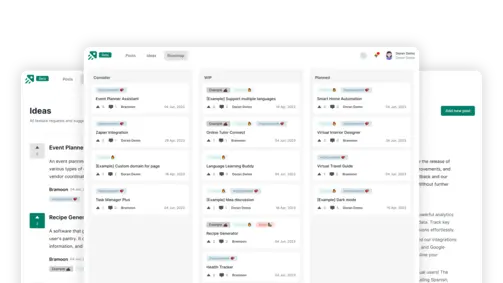Customer Equity: A Valuable Asset for Modern Businesses
Create changelog and product roadmap for your product
Explore nowTable of contents 7 min
In today’s highly competitive business landscape, understanding and leveraging customer equity is crucial for long-term success. By focusing on customer equity, businesses can develop strategies that enhance customer satisfaction, loyalty, and lifetime value. This article looks into the meaning of customer equity, its components, and its critical role in distinguishing brand equity from customer equity, providing actionable insights for companies and employees aiming to maximize their customer base’s value.
Customer Equity: Definition
The customer equity definition encapsulates the total combined value of all the company’s customers. It represents the future revenue that customers are expected to generate throughout their relationship with the business.
Unlike short-term financial metrics, customer equity focuses on the long-term profitability derived from customer relationships. It’s a forward-looking metric that helps businesses gauge the sustainability of their customer base and informs decisions about customer acquisition, retention, and marketing investments. The higher the customer equity, the more valuable the customer base is to the company, making it a vital indicator of business health and potential for growth.
Customer Equity Model: Explanation

The customer equity model is a framework that breaks down customer equity into three key components: value equity, brand equity, and relationship equity. These components help businesses understand the different factors that contribute to the overall value of their customer base, allowing them to develop targeted strategies for improvement.
Value Equity
Value equity refers to the customer’s objective assessment of the utility of a product or service based on what they pay for it. This component of customer equity is influenced by the quality of the product, the price, and the convenience of the purchase process.
For instance, if a company offers high-quality products at competitive prices, it’s likely to have high value equity. Businesses can enhance value equity by consistently delivering products and services that meet or exceed customer expectations in terms of quality, affordability, and convenience. By focusing on value equity, companies can attract more customers and increase the overall consumer equity of their business.
Brand Equity
Brand equity is another critical component of customer equity. It refers to the value that a brand adds to a product or service, based on customers’ perceptions, attitudes, and emotional connections with the brand.
Strong brand equity can lead to customer loyalty, premium pricing, and a competitive advantage in the market. Brands with high equity are often perceived as more trustworthy and desirable, which can significantly influence customer purchasing decisions.
Businesses can build brand equity by consistently delivering on their brand promise, maintaining a strong brand identity, and engaging with customers in meaningful ways. A robust brand equity not only enhances customer loyalty but also contributes to the overall customer equity by increasing the likelihood of repeat purchases and positive word-of-mouth.
Relationship Equity
Relationship equity refers to the strength of the relationship between a company and its customers. This component of customer equity is built on trust, customer service, personalized experiences, and loyalty programs that encourage long-term engagement.
Businesses with high relationship equity have customers who are not only loyal but also willing to advocate for the brand. Relationship equity can be enhanced by offering personalized experiences, maintaining consistent and transparent communication, and rewarding customer loyalty through incentives and exclusive offers. By focusing on building strong relationships, businesses can increase relationship equity and, in turn, boost their overall customer equity.
Read more: Top 9 Customer Success Metrics You Should Prioritize
What Makes Customer Equity Crucial?

Customer equity is crucial because it provides a comprehensive view of the long-term value of a company’s customer base. By focusing on customer equity, businesses can make informed decisions about where to allocate resources, how to improve customer satisfaction, and which marketing strategies will yield the highest return on investment.
Unlike other metrics that may focus on short-term gains, customer equity takes into account the lifetime value of customers, ensuring that businesses are not just acquiring customers but also retaining them and maximizing their value over time.
Moreover, customer equity serves as a predictor of future cash flows and overall business sustainability, making it an essential metric for companies aiming to achieve long-term success.
Another reason customer equity is crucial is its impact on competitive advantage. Companies that have high customer equity are better positioned to withstand market challenges and fluctuations because they have a loyal customer base that generates consistent revenue.
Furthermore, businesses with strong customer equity can invest more in innovation, customer service, and marketing, further strengthening their market position. In essence, customer equity is not just a measure of current success but a key driver of future growth and stability.
What Distinguishes Brand Equity from Customer Equity?

While customer equity and brand equity are closely related, they are distinct concepts with different implications for a business’s marketing strategy and overall success. Understanding the differences and the connections between these two forms of equity is essential for businesses looking to maximize their value and enhance customer satisfaction.
Brand Equity: Definition
The brand equity definition refers to the value that a brand adds to a product or service beyond the functional benefits it provides. This value is derived from customer perceptions, experiences, and emotional connections with the brand.
Strong brand equity often leads to higher customer loyalty, the ability to charge premium prices, and a stronger market presence.
For example, a brand like Apple has significant brand equity because of its reputation for quality, innovation, and design, which allows it to command higher prices and maintain a loyal customer base. In this context, brand equity is a critical driver of customer equity because a strong brand can attract and retain more valuable customers.
The Connection Between Customer Equity and Brand Equity
The relationship between customer equity and brand equity is synergistic. While customer equity represents the total value of a company’s customer base, brand equity is one of the key drivers that contribute to this value.
A strong brand enhances customer equity by increasing the likelihood of repeat purchases, customer loyalty, and positive word-of-mouth. Conversely, high customer equity can reinforce and enhance brand equity by creating a loyal customer base that acts as brand advocates, further strengthening the brand’s market position.
However, it’s important to note that customer equity encompasses more than just brand equity.
While brand equity focuses on the value added by the brand itself, customer equity includes all factors that contribute to the overall value of the customer base, including value equity and relationship equity. This broader perspective allows businesses to take a more holistic approach to marketing and customer management, ensuring that they are not just building a strong brand but also maximizing the lifetime value of their customers.
By integrating strategies that enhance both brand equity and customer equity, businesses can create a powerful competitive advantage and drive long-term success.
Read more: 10+ Customer Satisfaction Metrics for Business Success
Conclusion
In conclusion, customer equity is a valuable asset that modern businesses cannot afford to overlook. By understanding the meaning of customer equity and the customer equity definition, companies can better appreciate the long-term value of their customer base and develop strategies to enhance it. By focusing on building and maintaining high customer equity, businesses can improve customer satisfaction, foster loyalty, and ensure sustained profitability in an increasingly competitive market.
What to not miss out on our blog
Gain insightful knowledge and invaluable experiences from dedicated experts.

CRM System Explained: Benefits, Types, and How It Works
Discover everything about CRM system. Learn the benefits and how a CRM system works to improve customer relationships and streamline business operations.

Are you ready? Start your free trial today.
Enhance communication, keep track of the progress, understand customers' insight and more by taking your first trial on Doran.
Sign up for free

